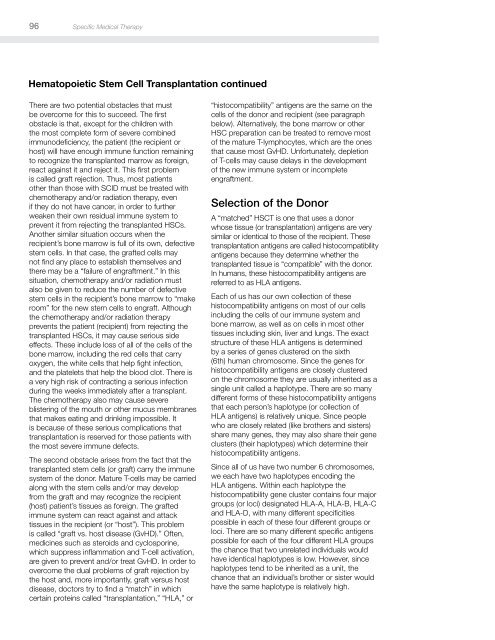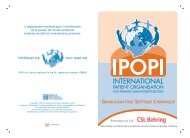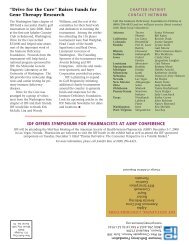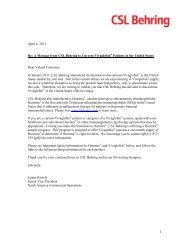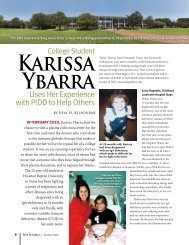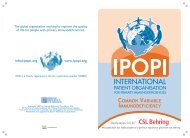IDF Patient & Family Handbook for Primary Immunodeficiency ... - IDFA
IDF Patient & Family Handbook for Primary Immunodeficiency ... - IDFA
IDF Patient & Family Handbook for Primary Immunodeficiency ... - IDFA
Create successful ePaper yourself
Turn your PDF publications into a flip-book with our unique Google optimized e-Paper software.
96 Specific Medical Therapy<br />
Hematopoietic Stem Cell Transplantation continued<br />
There are two potential obstacles that must<br />
be overcome <strong>for</strong> this to succeed. The first<br />
obstacle is that, except <strong>for</strong> the children with<br />
the most complete <strong>for</strong>m of severe combined<br />
immunodeficiency, the patient (the recipient or<br />
host) will have enough immune function remaining<br />
to recognize the transplanted marrow as <strong>for</strong>eign,<br />
react against it and reject it. This first problem<br />
is called graft rejection. Thus, most patients<br />
other than those with SCID must be treated with<br />
chemotherapy and/or radiation therapy, even<br />
if they do not have cancer, in order to further<br />
weaken their own residual immune system to<br />
prevent it from rejecting the transplanted HSCs.<br />
Another similar situation occurs when the<br />
recipient’s bone marrow is full of its own, defective<br />
stem cells. In that case, the grafted cells may<br />
not find any place to establish themselves and<br />
there may be a “failure of engraftment.” In this<br />
situation, chemotherapy and/or radiation must<br />
also be given to reduce the number of defective<br />
stem cells in the recipient’s bone marrow to “make<br />
room” <strong>for</strong> the new stem cells to engraft. Although<br />
the chemotherapy and/or radiation therapy<br />
prevents the patient (recipient) from rejecting the<br />
transplanted HSCs, it may cause serious side<br />
effects. These include loss of all of the cells of the<br />
bone marrow, including the red cells that carry<br />
oxygen, the white cells that help fight infection,<br />
and the platelets that help the blood clot. There is<br />
a very high risk of contracting a serious infection<br />
during the weeks immediately after a transplant.<br />
The chemotherapy also may cause severe<br />
blistering of the mouth or other mucus membranes<br />
that makes eating and drinking impossible. It<br />
is because of these serious complications that<br />
transplantation is reserved <strong>for</strong> those patients with<br />
the most severe immune defects.<br />
The second obstacle arises from the fact that the<br />
transplanted stem cells (or graft) carry the immune<br />
system of the donor. Mature T-cells may be carried<br />
along with the stem cells and/or may develop<br />
from the graft and may recognize the recipient<br />
(host) patient’s tissues as <strong>for</strong>eign. The grafted<br />
immune system can react against and attack<br />
tissues in the recipient (or “host”). This problem<br />
is called “graft vs. host disease (GvHD).” Often,<br />
medicines such as steroids and cyclosporine,<br />
which suppress inflammation and T-cell activation,<br />
are given to prevent and/or treat GvHD. In order to<br />
overcome the dual problems of graft rejection by<br />
the host and, more importantly, graft versus host<br />
disease, doctors try to find a “match” in which<br />
certain proteins called “transplantation,” “HLA,” or<br />
“histocompatibility” antigens are the same on the<br />
cells of the donor and recipient (see paragraph<br />
below). Alternatively, the bone marrow or other<br />
HSC preparation can be treated to remove most<br />
of the mature T-lymphocytes, which are the ones<br />
that cause most GvHD. Un<strong>for</strong>tunately, depletion<br />
of T-cells may cause delays in the development<br />
of the new immune system or incomplete<br />
engraftment.<br />
Selection of the Donor<br />
A “matched” HSCT is one that uses a donor<br />
whose tissue (or transplantation) antigens are very<br />
similar or identical to those of the recipient. These<br />
transplantation antigens are called histocompatibility<br />
antigens because they determine whether the<br />
transplanted tissue is “compatible” with the donor.<br />
In humans, these histocompatibility antigens are<br />
referred to as HLA antigens.<br />
Each of us has our own collection of these<br />
histocompatibility antigens on most of our cells<br />
including the cells of our immune system and<br />
bone marrow, as well as on cells in most other<br />
tissues including skin, liver and lungs. The exact<br />
structure of these HLA antigens is determined<br />
by a series of genes clustered on the sixth<br />
(6th) human chromosome. Since the genes <strong>for</strong><br />
histocompatibility antigens are closely clustered<br />
on the chromosome they are usually inherited as a<br />
single unit called a haplotype. There are so many<br />
different <strong>for</strong>ms of these histocompatibility antigens<br />
that each person’s haplotype (or collection of<br />
HLA antigens) is relatively unique. Since people<br />
who are closely related (like brothers and sisters)<br />
share many genes, they may also share their gene<br />
clusters (their haplotypes) which determine their<br />
histocompatibility antigens.<br />
Since all of us have two number 6 chromosomes,<br />
we each have two haplotypes encoding the<br />
HLA antigens. Within each haplotype the<br />
histocompatibility gene cluster contains four major<br />
groups (or loci) designated HLA-A, HLA-B, HLA-C<br />
and HLA-D, with many different specificities<br />
possible in each of these four different groups or<br />
loci. There are so many different specific antigens<br />
possible <strong>for</strong> each of the four different HLA groups<br />
the chance that two unrelated individuals would<br />
have identical haplotypes is low. However, since<br />
haplotypes tend to be inherited as a unit, the<br />
chance that an individual’s brother or sister would<br />
have the same haplotype is relatively high.


